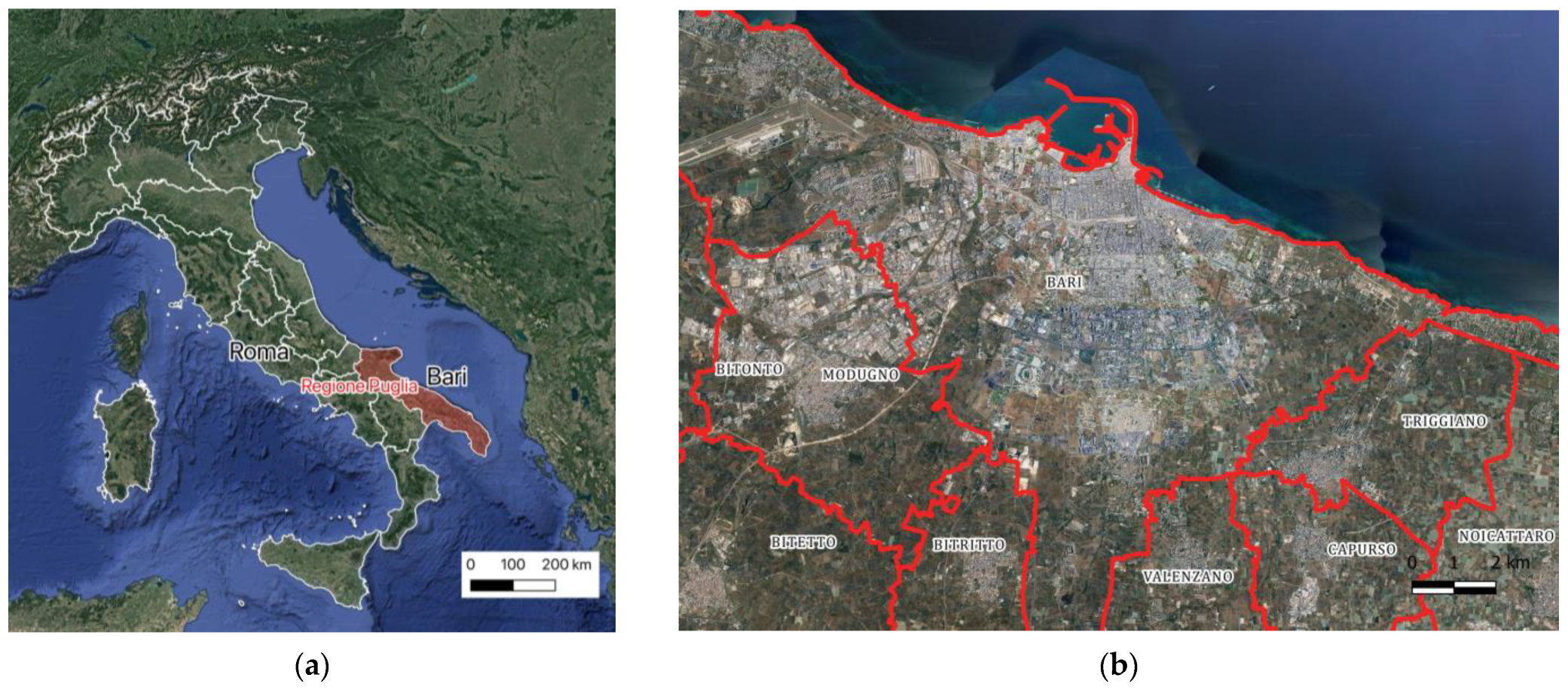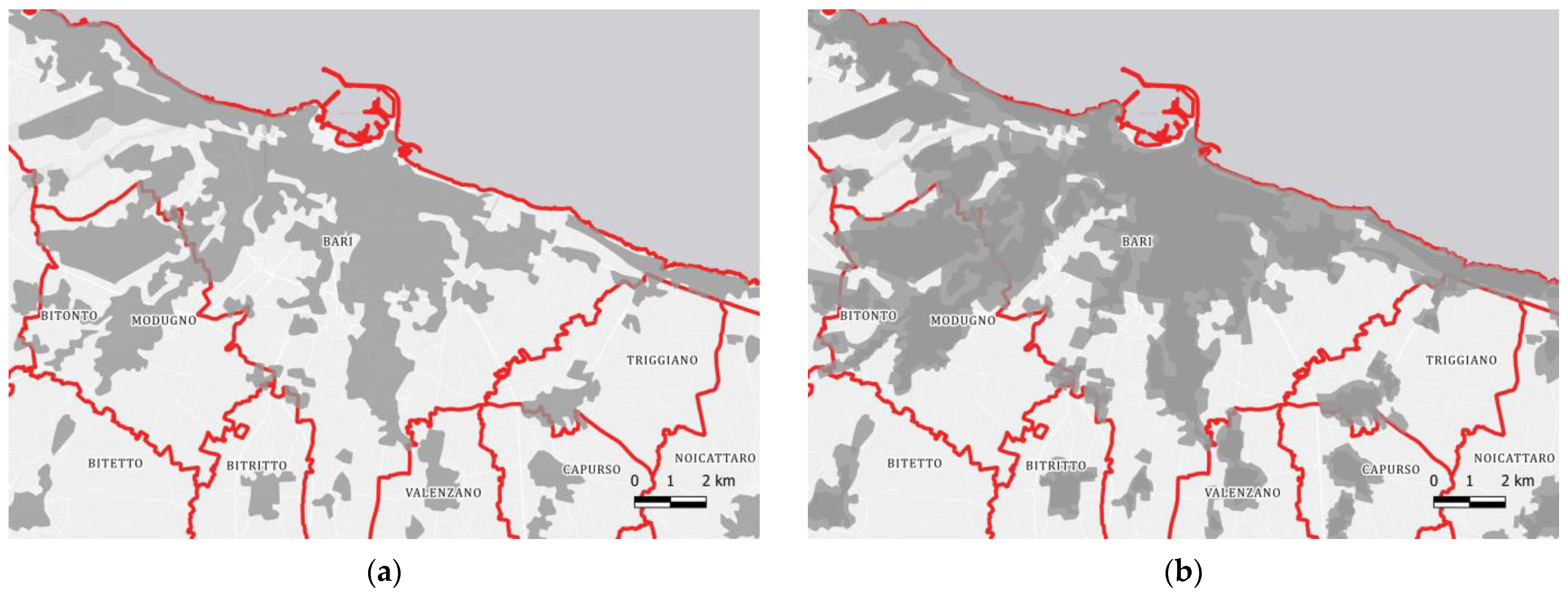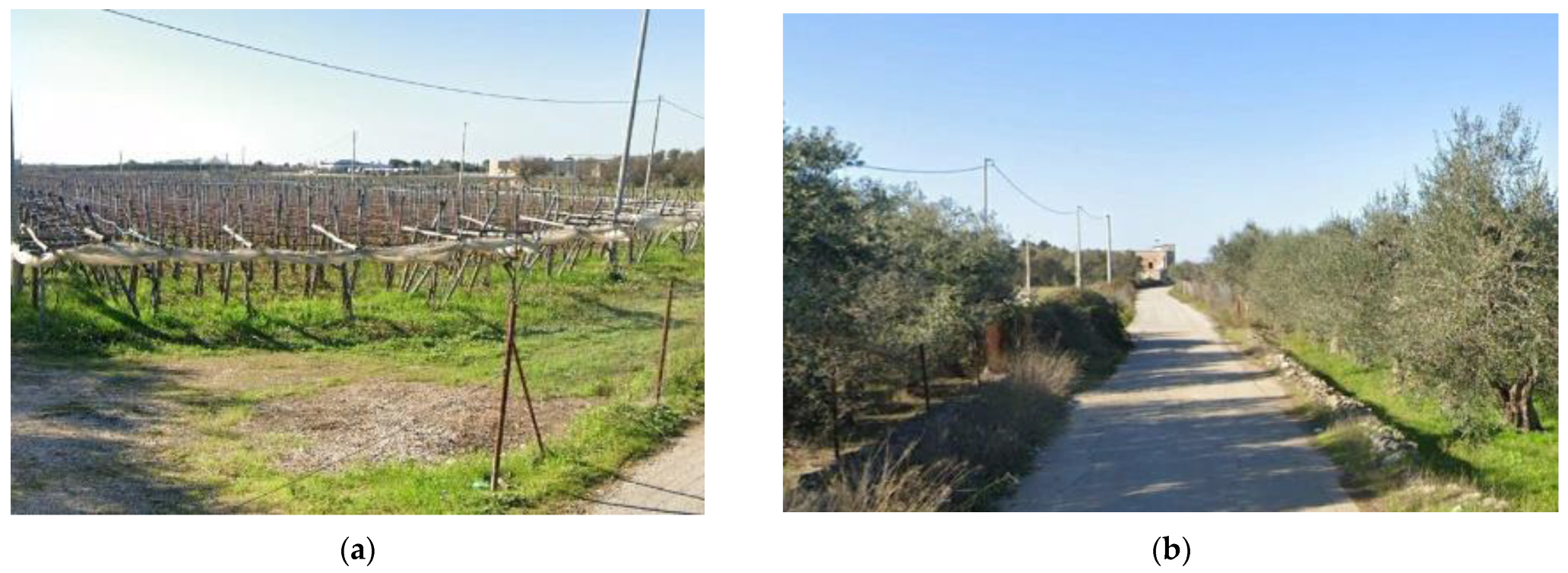The Value of Agricultural Areas: An Estimation Model of the Area to the Southeast of the City of Bari
Abstract
1. Introduction
2. Materials and Methods
2.1. The Linear Regression Model
2.1.1. Construction of the Database
- Registration number;
- Registration date;
- Notary public;
- Seller typology and quantity;
- Buyer typology and quantity;
- Municipality;
- Location;
- Cadastral map;
- Cadastral parcel;
- Cadastral cultivation quality;
- Lot area;
- Land income;
- Sale price;
- Land Use;
- Characterizing elements: access, rights of way, possession of title, etc.
2.1.2. Considerations of the Sample
2.2. Identification of Variables
- Surface (Sur);
- Year of sale (YS);
- Topsoil (TS);
- Possibility of building in rural area (PoBuRA);
- Soil defects (SD);
- Access to the main roads (AMR);
- Distance from the town (DT).
2.3. Structuring of Variables
- The surface variable (Sur): these variable expresses land area in square meters;
- The year of sale variable (YS): this variable defines the year of stipulation of the contract of sale, to consider temporal variations in pricing;
- The topsoil variable (TS): this variable identifies the different cultivations practiced; given the identification of a substantial difference only between arable land and all other typologies of cultivation (vineyards, olive groves, orchards, etc.), this variable was defined on a dichotomic scale: arable/pasture = 0 and olive grove/vineyard/orchard = 1;
- The possibility of building in rural area variable (PoBuRA): this variable uses a dichotomic scale (0 = absence; 1 = presence) to express the possibility of building homes on agricultural land. To better comprehend the significance of this variable, it is worth specifying that, according to Italian legislation, in agricultural areas (indicated in Municipal Master Plans—Piani Regolatori Generali Comunali-PRGC—with the code “E”) it is possible to build homes with a maximum floor area ratio of 0.03 m3/sqm. This ratio refers to a minimum plot size, specified in each PRG. Precisely in relation to this latter aspect (specific to each municipality), it was noted that in the city of Bari the minimum area necessary in an agricultural area (Primary Activity A) is 5000 sqm, while in the town of Triggiano this number is 10,000 sqm (zones E2 and E3), or 50,000 sqm (zone E1). This means that it is easier to build in agricultural areas in Bari than in Triggiano (Table 2).
- The soil defects variable (SD): this variable uses a dichotomic scale (0 = absence; 1 = presence) to express the presence or not on the site of elements that affect land value (rocky terrain, outcropping rock, watercourses, etc.). These elements were identified through “virtual” site surveys;
- The access to the main roads variable (AMR): this variable uses a dichotomic scale (0 = absence; 1 = presence) to express the proximity to points of access to the site from principal road networks; this condition was verified for terrains situated less than 300 m from principal roads (provincial, state, paved municipal);
- The distance from the town variable (DT): this variable uses an ordinal scale to express the radial distance in meters, measured from the center of the terrain to the perimeter of the nearest inhabited area. The distance is the lesser of those between the two centers of reference (Bari and Triggiano).
3. Results
4. Discussion
5. Conclusions
Author Contributions
Funding
Data Availability Statement
Conflicts of Interest
Appendix A. Dataset
| ID a | Price (EUR/sm) b | Surface (Sur) (sm) c | Year of Sale (YS) d | Topsoil (TS) e | Possibility of Building in Rural Area (PoBuRA) f | Soil Defects (SD) g | Access to the Main Roads (AMR) h | Distance from the Town (DT) (m) i |
|---|---|---|---|---|---|---|---|---|
| 13 | 2.99 | 8.418 | 2019 | 1 | 1 | 0 | 0 | 1.440 |
| 16 | 3.33 | 1.800 | 2016 | 0 | 0 | 0 | 0 | 1.800 |
| 18 | 2.22 | 900 | 2016 | 0 | 0 | 1 | 0 | 1.800 |
| 19 | 1.82 | 1.920 | 2016 | 0 | 0 | 1 | 0 | 1.900 |
| 21 | 3.26 | 6.142 | 2018 | 1 | 1 | 0 | 0 | 1.300 |
| 23 | 2.56 | 4.685 | 2019 | 0 | 0 | 0 | 0 | 1.450 |
| 24 | 3.36 | 1.784 | 2017 | 0 | 0 | 0 | 0 | 1.650 |
| 26 | 2.41 | 2.075 | 2019 | 1 | 0 | 0 | 0 | 1.800 |
| 28 | 2.01 | 23.877 | 2017 | 0 | 1 | 0 | 0 | 770 |
| 31 | 1.99 | 1.508 | 2018 | 0 | 0 | 1 | 0 | 750 |
| 34 | 2.15 | 2.935 | 2018 | 1 | 0 | 0 | 0 | 950 |
| 35 | 2.57 | 7.789 | 2016 | 1 | 0 | 0 | 0 | 800 |
| 36 | 2.61 | 7.664 | 2016 | 1 | 0 | 0 | 0 | 800 |
| 37 | 2.44 | 7.375 | 2016 | 1 | 0 | 0 | 0 | 800 |
| 51 | 2.43 | 1.646 | 2019 | 1 | 0 | 0 | 0 | 500 |
| 54 | 2.48 | 2.823 | 2015 | 1 | 0 | 1 | 0 | 500 |
| 57 | 2.99 | 568 | 2017 | 1 | 0 | 0 | 0 | 1.500 |
| 58 | 1.79 | 558 | 2019 | 1 | 0 | 1 | 0 | 1.000 |
| 63 | 2.52 | 2.582 | 2018 | 1 | 0 | 0 | 0 | 750 |
| 69 | 2.38 | 10.068 | 2019 | 1 | 1 | 0 | 0 | 2.000 |
| 72 | 0.83 | 6.370 | 2019 | 1 | 0 | 0 | 0 | 500 |
| 76 | 3.30 | 3.792 | 2016 | 1 | 0 | 0 | 0 | 1.800 |
| 80 | 2.77 | 2.887 | 2018 | 1 | 0 | 0 | 0 | 680 |
| 84 | 2.39 | 2.935 | 2019 | 1 | 0 | 0 | 0 | 700 |
| 85 | 3.13 | 3.200 | 2018 | 1 | 0 | 0 | 0 | 700 |
| 86 | 2.81 | 1.067 | 2018 | 1 | 0 | 0 | 0 | 270 |
| 91 | 2.67 | 10.100 | 2019 | 1 | 1 | 0 | 0 | 800 |
| 93 | 2.10 | 1.523 | 2019 | 1 | 0 | 1 | 0 | 450 |
| 103 | 3.49 | 1.431 | 2016 | 1 | 0 | 0 | 0 | 2.000 |
| 104 | 1.92 | 6.499 | 2017 | 1 | 0 | 0 | 0 | 2.500 |
| 105 | 1.88 | 3.189 | 2019 | 1 | 0 | 0 | 0 | 1.800 |
| 107 | 2.01 | 4.975 | 2018 | 1 | 0 | 0 | 0 | 2.400 |
| 111 | 1.74 | 5.735 | 2019 | 0 | 0 | 0 | 0 | 2.400 |
| 113 | 1.72 | 6.992 | 2019 | 1 | 0 | 0 | 0 | 3.100 |
| 117 | 2.92 | 3.425 | 2019 | 1 | 0 | 0 | 0 | 900 |
| 118 | 2.66 | 640 | 2018 | 0 | 0 | 0 | 0 | 850 |
| 122 | 2.00 | 2.000 | 2019 | 1 | 0 | 0 | 0 | 900 |
| 123 | 2.42 | 1.654 | 2017 | 1 | 0 | 0 | 0 | 1.900 |
| 124 | 2.13 | 3.994 | 2017 | 1 | 0 | 0 | 0 | 2.500 |
| 125 | 1.96 | 6.114 | 2019 | 0 | 0 | 0 | 0 | 2.000 |
| 128 | 1.45 | 2.750 | 2019 | 1 | 0 | 1 | 0 | 500 |
| 129 | 4.16 | 1.202 | 2017 | 0 | 0 | 0 | 1 | 500 |
| 137 | 2.69 | 7.425 | 2017 | 1 | 0 | 0 | 0 | 1.800 |
| 139 | 2.81 | 1.425 | 2018 | 1 | 0 | 0 | 1 | 1.200 |
| 140 | 3.49 | 1.905 | 2018 | 0 | 0 | 0 | 1 | 1.200 |
| 141 | 3.53 | 950 | 2018 | 1 | 0 | 0 | 1 | 1.200 |
| 143 | 3.62 | 968 | 2017 | 1 | 0 | 0 | 1 | 1.600 |
| 144 | 3.27 | 459 | 2017 | 1 | 0 | 0 | 1 | 1.600 |
| 146 | 3.51 | 3.053 | 2018 | 1 | 0 | 0 | 1 | 2.000 |
| 148 | 3.51 | 2.643 | 2018 | 1 | 0 | 0 | 1 | 2.000 |
References
- Carbonara, S.; Stefano, D.; Di Prinzio, A. Transforming surface rights into property rights: An analysis of current estimation procedures and a comparison with an alternative. Valori Valutazioni. Teor. Ed. Esperienze 2020, 24, 5–17. [Google Scholar]
- Carbonara, S.; Stefano, D. The Valorisation of Public Real Estate Assets in Italy: A Critical Reconstruction of the Legislative Framework; Springer: Berlin/Heidelberg, Germany, 2021; pp. 475–485. [Google Scholar]
- Della Spina, L.; Carbonara, S.; Stefano, D.; Viglianisi, A. Sustainable collaborative strategies of territorial regeneration for the cultural enhancement of the unresolved landscapes. Land 2023, 12, 497. [Google Scholar] [CrossRef]
- Della Spina, L. Strategic Planning and Decision Making: A Case Study for the Integrated Management of Cultural Heritage Assets in Southern Italy; Springer International Publishing: Berlin/Heidelberg, Germany, 2021; pp. 1116–1130. [Google Scholar]
- Della Spina, L.; Rugolo, A. A Multicriteria Decision Aid Process for Urban Regeneration Process of Abandoned Industrial Areas; Springer International Publishing: Berlin/Heidelberg, Germany, 2021; pp. 1053–1066. [Google Scholar]
- Commoner, B. The Closing Circle: Nature, Man, and Technology; Knopf Doubleday Publishing Group: New York, NY, USA, 2014. [Google Scholar]
- Girard, L.F.; Nocca, F.; Gravagnuolo, A. Matera: City of nature, city of culture, city of regeneration. Towards a landscape-based and culture-based urban circular economy. Aestimum 2019, 74, 5–42. [Google Scholar]
- Cook, E. Agriculture, Forestry and Fishery Statistics, 2020th ed.; Eurostat (European Commission): Brussels, Belgium, 2020. [Google Scholar]
- Pham, V.C.; Pham, T.-T.-H.; Tong, T.H.A.; Nguyen, T.T.H.; Pham, N.H. The conversion of agricultural land in the peri-urban areas of Hanoi (Vietnam): Patterns in space and time. J. Land Use Sci. 2015, 10, 224–242. [Google Scholar] [CrossRef]
- Cotteleer, G.; Gardebroek, C.; Luijt, J. Market Power in a GIS-Based Hedonic Price Model of Local Farmland Markets. Land Econ. 2008, 84, 573–592. [Google Scholar] [CrossRef]
- Langemeyer, J.; Madrid-Lopez, C.; Beltran, A.M.; Mendez, G.V. Urban agriculture—A necessary pathway towards urban resilience and global sustainability? Landsc. Urban Plan. 2021, 210, 104055. [Google Scholar] [CrossRef]
- Chen, Y.-H.; Lee, C.-L.; Chen, G.-R.; Wang, C.-H.; Chen, Y.-H. Factors Causing Farmland Price-Value Distortion and Their Implications for Peri-Urban Growth Management. Sustainability 2018, 10, 2701. [Google Scholar] [CrossRef]
- Bonye, S.Z.; Yiridomoh, G.Y.; Derbile, E.K. Urban expansion and agricultural land use change in Ghana: Implications for peri-urban farmer household food security in Wa Municipality. Int. J. Urban Sustain. Dev. 2021, 13, 383–399. [Google Scholar] [CrossRef]
- Nigussie, S.; Liu, L.; Yeshitela, K. Towards improving food security in urban and peri-urban areas in Ethiopia through map analysis for planning. Urban For. Urban Green. 2021, 58, 126967. [Google Scholar] [CrossRef]
- Kocur-Bera, K. Adrian Conversion of agricultural land for urbanization purposes: A case study of the suburbs of the capital of Warmia and Mazury, Poland. Remote Sens. 2020, 12, 2325. [Google Scholar] [CrossRef]
- Carbonara, S.; Faustoferri, M.; Stefano, D. Real Estate Values and Urban Quality: A Multiple Linear Regression Model for Defining an Urban Quality Index. Sustainability 2021, 13, 13635. [Google Scholar] [CrossRef]
- Mollica, E.; Massimo, D.E. Valutazione degli strumenti del territorio e strumenti GIS. Aestimum 2002, 32, 710–757. [Google Scholar] [CrossRef]
- Fiorini, L.; Falasca, F.; Marucci, A.; Saganeiti, L. Discretization of the Urban and Non-Urban Shape: Unsupervised Machine Learning Techniques for Territorial Planning. Appl. Sci. 2022, 12, 10439. [Google Scholar] [CrossRef]
- Cole, B.; Smith, G.; de la Barreda-Bautista, B.; Hamer, A.; Payne, M.; Codd, T.; Johnson, S.C.M.; Chan, L.Y.; Balzter, H. Dynamic Landscapes in the UK Driven by Pressures from Energy Production and Forestry—Results of the CORINE Land Cover Map 2018. Land 2022, 11, 192. [Google Scholar] [CrossRef]
- Aguiar, A.P.D.; Câmara, G.; Escada, M.I.S. Spatial statistical analysis of land-use determinants in the Brazilian Amazonia: Exploring intra-regional heterogeneity. Ecol. Model. 2007, 209, 169–188. [Google Scholar] [CrossRef]
- Jasińska, E. Land use efficiency on example of the transformation of rural properties. In Proceedings of the 10th International Conference on Environmental Engineering, ICEE 2017, Vilnius, Lithuania, 27–28 April 2017. [Google Scholar]
- Carbonara, S.; Stefano, D.; Torre, C.M. The Economic Effect of Sale of Italian Public Property: A Relevant Question of Real Estate Appraisal; Springer International Publishing: Cham, Switzerland, 2014; pp. 459–470. [Google Scholar]
- Della Spina, L.; Giorno, C. Cultural Landscapes: A Multi-Stakeholder Methodological Approach to Support Widespread and Shared Tourism Development Strategies. Sustainability 2021, 13, 7175. [Google Scholar] [CrossRef]
- Della Spina, L. Revitalization of inner and marginal areas: A multi-criteria decision aid approach for shared development strategies. Valori Valutazioni 2020, 25, 37–44. [Google Scholar]






| Land Use | n. Cases | % | Average Price (EUR /sqm) |
|---|---|---|---|
| Agricultural Zone | 108 | 73.0% | 2.73 |
| Conservation Area | 7 | 4.7% | 1.18 |
| Urban Parkland | 7 | 4.7% | 5.70 |
| Equipment/Services | 3 | 2.0% | 9.86 |
| Urban Zones | 14 | 9.5% | 57.73 |
| Urban Settlements D | 5 | 3.4% | 31.70 |
| Urban Settlements B | 3 | 2.0% | 495.58 |
| Unplanned | 1 | 0.7% | 1.93 |
| Land Use | Triggiano | Bari | |||
|---|---|---|---|---|---|
| E1 | E2 | E3 | Zones for Type A Primary Activities | Zones for Type B Primary Activities | |
| Indice di Fabbricabilità Fondiaria—IFF (m3/sqm) | 0.03 | 0.03 | 0.03 | 0.03 | 0.01 |
| Min. Plot Size (sqm) | 50,000 | 10,000 | 10,000 | 5000 | 20,000 |
| Model | R | R-Squared | R-Squared Adapted | Std. Estimation Error | Durbin-Watson |
|---|---|---|---|---|---|
| 1 | 0.866 a | 0.749 | 0.708 | 0.36222 | 1.833 |
| Model | Sum of the Squares | gl | Root Mean Square | F | Sign | |
|---|---|---|---|---|---|---|
| 1 | Regression | 16,472 | 7 | 2353 | 17,935 | 0.000 b |
| Residual | 5510 | 42 | 0.131 | |||
| Total | 21,982 | 49 | ||||
| Model | Non Standardized Coefficients | Standardized Coefficients | t | Sign. | ||
|---|---|---|---|---|---|---|
| B | Standard Error | Beta | ||||
| 1 | (Constant) | 525.8032 | 95.074 | 5.530 | 0.000 | |
| Sur | −0.000105 | 0.000 | −0.614 | −5.371 | 0.000 | |
| YS | −0.258998 | 0.047 | −0.446 | −5.498 | 0.000 | |
| TS | −0.159976 | 0.125 | −0.103 | −1.284 | 0.206 | |
| PoBuRA | 1.165973 | 0.239 | 0.528 | 4.869 | 0.000 | |
| SD | −0.902504 | 0.167 | −0.472 | −5.407 | 0.000 | |
| AMR | 0.731430 | 0.152 | 0.404 | 4.821 | 0.000 | |
| DT | −0.000146 | 0.000 | −0.141 | −1.765 | 0.085 | |
Disclaimer/Publisher’s Note: The statements, opinions and data contained in all publications are solely those of the individual author(s) and contributor(s) and not of MDPI and/or the editor(s). MDPI and/or the editor(s) disclaim responsibility for any injury to people or property resulting from any ideas, methods, instructions or products referred to in the content. |
© 2023 by the authors. Licensee MDPI, Basel, Switzerland. This article is an open access article distributed under the terms and conditions of the Creative Commons Attribution (CC BY) license (https://creativecommons.org/licenses/by/4.0/).
Share and Cite
Carbonara, S.; Stefano, D.; Fischetti, M.; Della Spina, L. The Value of Agricultural Areas: An Estimation Model of the Area to the Southeast of the City of Bari. Land 2023, 12, 1431. https://doi.org/10.3390/land12071431
Carbonara S, Stefano D, Fischetti M, Della Spina L. The Value of Agricultural Areas: An Estimation Model of the Area to the Southeast of the City of Bari. Land. 2023; 12(7):1431. https://doi.org/10.3390/land12071431
Chicago/Turabian StyleCarbonara, Sebastiano, Davide Stefano, Michele Fischetti, and Lucia Della Spina. 2023. "The Value of Agricultural Areas: An Estimation Model of the Area to the Southeast of the City of Bari" Land 12, no. 7: 1431. https://doi.org/10.3390/land12071431
APA StyleCarbonara, S., Stefano, D., Fischetti, M., & Della Spina, L. (2023). The Value of Agricultural Areas: An Estimation Model of the Area to the Southeast of the City of Bari. Land, 12(7), 1431. https://doi.org/10.3390/land12071431











